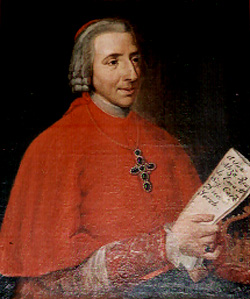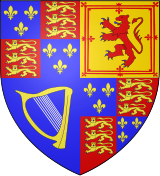Henry Benedict Stuart
| Henry Benedict Stuart | |
|---|---|
 |
|
| Henry Benedict Stuart, "Cardinal-Duke of York" | |
| Jacobite pretender | |
| Pretendence | 31 January 1788 - 13 July 1807 |
| Predecessor | Charles III |
| Successor | Charles IV |
| Full name | Henry Benedict Maria Clement Thomas Francis Xavier Stuart |
| Royal house | House of Stuart |
| Father | "James III and VIII" |
| Mother | Maria Klementyna Sobieska |
| Born | 11 March 1725 Rome, Italy |
| Died | 13 July 1807 (aged 82) Frascati, Rome |
| Burial | St. Peter's Basilica, Vatican City |
Henry Benedict Cardinal Stuart (11 March 1725 – 13 July 1807) was the fourth and final Jacobite heir to publicly claim the thrones of England, Scotland, and Ireland. Unlike his father, James Francis Edward Stuart, and brother, Charles Edward Stuart, Henry made no effort to seize the throne. After Charles's death in January 1788 the Papacy did not recognise Henry as the lawful ruler of England, Scotland and Ireland, but referred to him as the Cardinal Duke of York.[1]
He spent his life in the Papal States and had a long career in the clergy of the Roman Catholic Church, rising to become the Dean of the College of Cardinals and Cardinal-Bishop of Ostia and Velletri. At the time of his death he was (and still is) one of the longest serving Cardinals in the Church's history.
In his youth, Henry's father made him Duke of York (in the Jacobite peerage), and it was by this title that he was best known. Upon the death of his brother in 1788 Henry became known by Jacobites, and within his personal entourage, as Henry IX of England, although publicly he referred to himself as Cardinal-Duke of York nuncupatus.
Notwithstanding his claim to the throne, Henry was in general a peaceable man, attentive to his duties, well respected and a generous host in Rome to many English and Scottish visitors, both Roman Catholic and Protestant.
Contents |
Early life
Henry Benedict Maria Clement Thomas Francis Xavier Stuart was born in exile at Rome on 6 March 1725 and baptized on the same day by Pope Benedict XIII, 37 years after his grandfather James II of Great Britain lost the throne, and ten years after his father's failed attempt to regain it. His father was James Francis Edward Stuart, known to his opponents as "the Old Pretender". His mother was the Princess Maria Klementyna Sobieska, granddaughter of the Polish King, John III Sobieski.

Henry went to France in 1745 to help his brother, Prince Charles Edward Stuart ("Bonnie Prince Charlie", or "the Young Pretender") prepare the Jacobite campaign of that year. After its defeat, Henry Stuart returned to Italy. On 30 June 1747 Pope Benedict XIV conferred him with tonsure and created him Cardinal-Deacon of S. Maria in Portico in special consistory held on the 3 July 1747. On 27 August 1747 he was promoted to the four minor orders by the Pope. He received the subdiaconate on 18 August 1748 and diaconate on 25 August 1748. He was ordained priest on 1 September 1748 and consecrated titular Archbishop of Corinth on 2 October 1758.
| Scottish and English Royalty |
|---|
| House of Stuart |
 |
| James II & VII |
| Mary II |
| Anne |
| James Francis Edward Stuart |
| Grandchildren |
| Charles Edward Stuart |
| Henry Benedict Stuart |
He was advanced to the order of Cardinal Priest in 1748, maintaining title to S. Maria in Portico. In 1752 he transferred to the titulus of Ss. XII Apostoli. He was made Cardinal-Bishop of Frascati on 13 July 1761, and eventually succeeded to the See of Ostia and Velletri on his appointment as Dean of the Sacred College of Cardinals on 26 September 1803. He lived and worked in Frascati for many years, descending each afternoon in his carriage to Rome, where his position as vice-chancellor entitled him to the Palazzo della Cancelleria.
Henry was the last claimant to the English throne to touch for the King's Evil.
French Revolution and later life
At the time of the French Revolution, he lost his French Royal benefices and sacrificed many other resources to assist Pope Pius VI. This, in addition to the seizure of his Frascati property by the French, caused him to descend into poverty. The British Minister in Venice arranged for Henry to receive an annuity of £4,000 from King George III of Great Britain. Although the British government represented this as an act of charity, Henry and the Jacobites considered it to be a first installment on the money which was legally owed to him. (For many years the British government had promised to return the English dowry of his grandmother, Mary of Modena, but had never actually done so.)
Henry returned to Frascati in 1803. In September of that year he became the Dean of the College of Cardinals and hence Cardinal Bishop of Ostia and Velletri, though he still lived in the episcopal palace at Frascati. He died there on 13 July 1807, aged 82.
Personal relationships
Historians have drawn upon the evidence of contemporaries to explore the suggestion that Henry was homosexual[2]. These accounts include the writings of Hester Lynch Thrale[3] (1741-1821), and the diplomat and writer Giuseppe Gorani[4] (1740-1819). However, Gorani admitted to not having gathered sufficient evidence to confirm his suspicions either way.
The writer Gaetano Moroni[5] provides the lengthiest account of Henry’s close attachment with Monsignor Lercari, his majordomo. This led to tensions between the cardinal and his father who tried to have Lercari dismissed from service and sent from Rome. A public scandal was only narrowly avoided after the personal intervention of Pope Benedict XIV.
From 1769 onwards Henry remained close to Monsignor Angelo Cesarini, a nobleman from Perugia, who thanks to Henry’s protection, won various honours, was made canon of the cathedral in Frascati, and finally in 1801 became Bishop of Milevi. When Henry died, Cesarini was still at his side, as he had been for 40 years. Caution should be given, however, against assuming any active sexual relationships, because equally clear in contemporary sources is York's proper and virtuous nature, and horror of all impropriety.[6]
Post mortem

Under his will, which he signed as "Henry R", he was succeeded in all his claimed British rights by his friend and nearest blood-relative, Charles Emmanuel IV of Sardinia. But Charles never publicly claimed nor renounced his Jacobite rights, nor have any of his successors to this day.
Contrary to popular belief, he did not leave the Crown Jewels to the Prince of Wales, afterwards George IV of the United Kingdom. All his property was entrusted to Monsignor Angelo Cesarini, for distribution. Cesarini sent the Prince of Wales several jewels from Henry's private collection. These included a "Lesser George" (thought to have been worn by Charles I at his execution, and now at Windsor Castle) and a St Andrew's Cross (now at Edinburgh Castle in Edinburgh), which are insignia of the orders of the Garter and the Thistle, and also a ruby ring.
A new sarcophagus was needed when the bodies were moved in 1938. It is widely held that the cost of that new sarcophagus was paid by King George VI.
Henry Benedict, his brother, his father and his mother are buried in the crypt of St. Peter's Basilica in the Vatican. There is a monument to the Royal Stuarts designed by Antonio Canova in the basilica to their memory on one of the columns in the basilica proper. This was restored within living memory at the expense of Queen Elizabeth the Queen Mother.
Titles, styles, honours and arms
Cardinalatial titles
During his life, Cardinal Stuart was assigned the following Diaconia and Tituli:
- July 13, 1747 Cardinal Deacon of Santa Maria in Portico
- September 16, 1748 Cardinal Priest of Santa Maria in Portico
- December 18, 1752 Cardinal Priest of Santi XII Apostoli
- February 12, 1759 Cardinal Priest of Santa Maria in Trastevere
- July 13, 1761 Cardinal Bishop of Frascati
- January 14, 1763 Comendatario of San Lorenzo in Damaso (proper of the cardinal vice-chancellor, held in addition to the suburbicarian sees)
- September 26, 1803 Cardinal Bishop of Ostia e Velletri (proper of the dean of the Sacred College of Cardinals)
In March 1774 he became Sub-dean, and on September 15, 1803 - Dean of the Sacred College of Cardinals.
He was a cardinal elector in the papal conclaves of 1758, 1769, 1774-75 and 1799-1800.
Arms
During the pretence of his father and brother, Henry claimed a coat of arms consisting of those of the kingdom, differenced by a crescent argent[7]
Ancestors
| Ancestors of Henry Benedict Stuart | ||||||||||||||||||||||||||||||||||||||||||||||||||||||||||||||||||||||||||||||||||||||||||||||||||||||||||||||||||||||||||||||||||||||||||||||||||||||||||||||||||||||||||||||||||||||||||||||||||||||||||||||||||||||||||||||||||||||||||||||||||||||||||||||||||||||||||||||||||||||||||||||||||||||||||||||||||||||||||||||||||||||||||||||||||||||||||||||||||||||||||||||||||||||||||||||||||||||||||||||||||||||||||||||||||||||||||||||||||||||||||||||||||||||||||||||||||||||||||||||||||||||||||||||||||||||||||||||||||||||||||||||||||||||||||||||||||
|---|---|---|---|---|---|---|---|---|---|---|---|---|---|---|---|---|---|---|---|---|---|---|---|---|---|---|---|---|---|---|---|---|---|---|---|---|---|---|---|---|---|---|---|---|---|---|---|---|---|---|---|---|---|---|---|---|---|---|---|---|---|---|---|---|---|---|---|---|---|---|---|---|---|---|---|---|---|---|---|---|---|---|---|---|---|---|---|---|---|---|---|---|---|---|---|---|---|---|---|---|---|---|---|---|---|---|---|---|---|---|---|---|---|---|---|---|---|---|---|---|---|---|---|---|---|---|---|---|---|---|---|---|---|---|---|---|---|---|---|---|---|---|---|---|---|---|---|---|---|---|---|---|---|---|---|---|---|---|---|---|---|---|---|---|---|---|---|---|---|---|---|---|---|---|---|---|---|---|---|---|---|---|---|---|---|---|---|---|---|---|---|---|---|---|---|---|---|---|---|---|---|---|---|---|---|---|---|---|---|---|---|---|---|---|---|---|---|---|---|---|---|---|---|---|---|---|---|---|---|---|---|---|---|---|---|---|---|---|---|---|---|---|---|---|---|---|---|---|---|---|---|---|---|---|---|---|---|---|---|---|---|---|---|---|---|---|---|---|---|---|---|---|---|---|---|---|---|---|---|---|---|---|---|---|---|---|---|---|---|---|---|---|---|---|---|---|---|---|---|---|---|---|---|---|---|---|---|---|---|---|---|---|---|---|---|---|---|---|---|---|---|---|---|---|---|---|---|---|---|---|---|---|---|---|---|---|---|---|---|---|---|---|---|---|---|---|---|---|---|---|---|---|---|---|---|---|---|---|---|---|---|---|---|---|---|---|---|---|---|---|---|---|---|---|---|---|---|---|---|---|---|---|---|---|---|---|---|---|---|---|---|---|---|---|---|---|---|---|---|---|---|---|---|---|---|---|---|---|---|---|---|---|---|---|---|---|---|---|---|---|---|---|---|---|---|---|---|---|---|---|---|---|---|---|---|---|---|---|---|---|---|---|---|---|---|---|---|---|---|---|---|---|---|---|---|---|---|---|---|---|---|---|---|---|---|---|---|---|---|---|---|---|---|---|---|---|---|---|---|---|---|---|---|---|---|---|---|---|---|---|---|---|---|---|---|---|---|---|---|---|---|---|---|---|---|---|---|---|---|---|---|---|---|---|---|---|---|---|---|---|---|---|---|---|---|---|---|---|---|---|---|---|---|---|---|---|---|---|---|---|---|---|---|---|---|---|
|
||||||||||||||||||||||||||||||||||||||||||||||||||||||||||||||||||||||||||||||||||||||||||||||||||||||||||||||||||||||||||||||||||||||||||||||||||||||||||||||||||||||||||||||||||||||||||||||||||||||||||||||||||||||||||||||||||||||||||||||||||||||||||||||||||||||||||||||||||||||||||||||||||||||||||||||||||||||||||||||||||||||||||||||||||||||||||||||||||||||||||||||||||||||||||||||||||||||||||||||||||||||||||||||||||||||||||||||||||||||||||||||||||||||||||||||||||||||||||||||||||||||||||||||||||||||||||||||||||||||||||||||||||||||||||||||||||
See also
- Touch pieces
External links
Notes
References
- Angeli, Diego (1931) Storia romana di trent'anni, 1770-1800, Milano : Treves, 276 p.
- Gorani, Giuseppe, Count (1793) Mémoires secrets et critiques des cours, des gouvernemens, et des mœurs des principaux états de l'Italie, v. 2, Paris
- MacLeod, John (1999) Dynasty, the Stuarts, 1560–1807, London : Hodder and Stoughton, ISBN 0-340-70767-4.
- Marshall, Rosalind K. (2006) '‘Henry Benedict (1725–1807)’', Oxford Dictionary of National Biography, Oxford University Press, doi:10.1093/ref:odnb/12964 [accessed 30 November, 2008]
- Piozzi, Hester Lynch (1951) Thraliana : the diary of Mrs. Hester Lynch Thrale (later Mrs. Piozzi), 1776-1809, (Katharine C.Balderston; ed.), v. 2: 1784-1809, 2nd ed., Oxford : Clarendon Press in co-operation with the Huntingdon Library, 611-1191p.
- Schofield, N. (ed.) (2002) A Roman miscellany : the English in Rome, 1550-2000, Leominster : Gracewing, ISBN 0-85244-575-X
|
Henry Benedict Stuart
Born: 11 March 1725 Died: 13 July 1807 |
||
| Titles in pretence | ||
|---|---|---|
| Preceded by Charles III |
Jacobite succession 1788–1807 |
Succeeded by Charles IV |
| Roman Catholic Church titles | ||
| Preceded by Gian Francesco Albani |
Cardinal-bishop of Ostia 1803-1807 |
Succeeded by Leonardo Antonelli |
| Preceded by Giovanni Cardinal Albani |
Dean of the College of Cardinals 1803–1807 |
Succeeded by Leonardo Cardinal Antonelli |
|
|||||